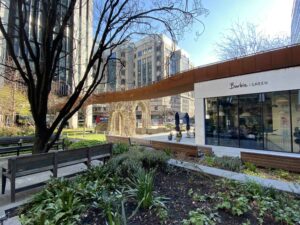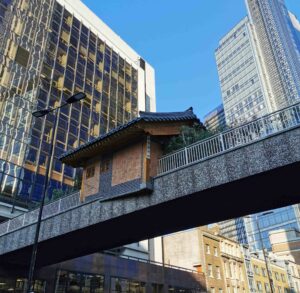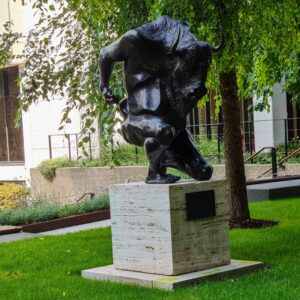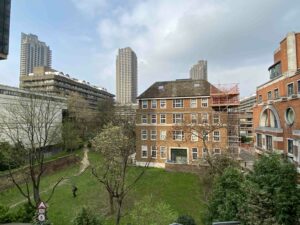As City of London tour guides we’re always looking for ways to present the city from different perspectives. And so it was in 2018, while poking around the rear of Guildhall in search of such inspiration, that I stumbled upon a sign that read Barbican Highwalks.
Some 40 steps up later (jolly good exercise – though you can also use the lift) I found myself on an elegant weathered steel walkway lined with polished wood and stretches of lush greenery winding between modern office buildings and over ancient landmarks. This was the rejuvenated Barbican Highwalk – unloved post war urban planning that like a middle-aged celebrity has a shiny new face to present to the world.

Each section of the Highwalk system is named according its location, e.g. Bassishaw, St Alphage or Moorgate, which is useful as it can be all too easy to lose your bearings when you’re walking in the air, and lead in a matter of minutes to either Moorgate, The Barbican Centre or the Museum of London.
How it all began
The Highways were hatched following World War 2 – to fill the reconstructed City with a pedway system (albeit more functional than fabulous) that would lift pedestrians out of the way of increasingly dangerous fast moving traffic in the post war city.
Planning regulations were drawn up which stipulated that every new-build office should have pedway access built into it. The problem was that while there was an overall vision – there was no detailed plan of how the pedways would link up. And then there was the thorny question of access for emergency services, as well as the problem of ‘contrary’ pedestrian behaviour. It became apparent that when it comes to getting from a to b, people tended to prefer pavements to pedways.
The Barbican Highwalk today
By the 1980s the planning regulation was dropped and the ’utopian’ vision quietly bit the dust, although you can spot the remains of that idea all over the city today; blocked up pedways jutting from office blocks and pedestrian bridges that go nowhere. One near Liverpool Street Station attracted attention in 2018 when artist Do Ho Suh ‘impaled’ a Korean House across it, designed to look as though it had just dropped out of the sky.

In fact the only part of the City in which the pedway system was most fully realised exists today at the Barbican complex, and now with the Barbican Highwalk extension to Guildhall and Moorgate, city workers living on the estate can finally take the pedway short-cut to the city centre. It’s nearly 50 years late, but who’s counting?
For the rest of us, well, let’s call it a sightseeing opportunity. You won’t even need a map. The route is all on one level – just follow the signposts.
What to look out for: St Alphage Highwalk
From The St Alphage Highwalk you can look down onto London Wall Place, one the city’s newest open spaces. A stretch of the old Roman city wall complete with Tudor repairs divides two garden areas. The sunken Salters’ Garden is laid out in the form of an English knot garden, filled with roses in the summer months, though be warned – there’s a Minotaur stalking the area!

From the Highwalk look across the main London Wall road and you’ll see the Roman wall continuing its route south along Noble Street, a section which includes the remains of the Roman Fort, uncovered during the Blitz in World War 2.
On the south side of the wall you’ll find the tower and arches of the medieval hospital of Elsyng Spital founded in 1330. It was originally part of an Augustinian priory until it was closed in 1536. It was rebuilt as a college then a private house before being rebuilt as the Church of St Alphage in the 1770s, meeting it’s ultimate fate during the Blitz.
It’s here at the St Alphage section that you can descend via steps or a lift to explore the area more closely, and perhaps stop for lunch or coffee and cake at Barbie Green (look out for the Six in the City restaurant review,coming soon).
What to look out for: Bastion Highwalk
This stretch of the Highwalk continues over Wood Street. Then you have a choice. Turn right and you’ll be entering the fascinating fortress-like Barbican complex. Turn left and you’ll be following signs to the Museum of London. On reaching the Bastion Highwalk you’ll pass the home of one of the oldest livery companies in the city, the Worshipful Company of Barbers.
Barber-Surgeons’ Hall, rebuilt after World War 2 is a reminder of the freedom barbers had in medieval times to perform surgery in monastic hospitals. The garden is open to the public and contains not only the remains of one of the Roman bastions but also the Barbers’ Company Herb Garden – a collection of 45 species grown for use in the treatment of wounds, bruises and burns.

The final destination on this Highwalk trail is the Museum of London itself – it’s totally fascinating, free to enter and open 7 days a week, with a shop and café. A couple of hours here will be time well spent, but you’ve got until December to visit, as that’s when the museum is due to close for good in preparation for its move to West Smithfield – due to reopen there in 2025.
Finally – cross over the footbridge outside the museum and you’ll find a craftily concealed escalator which will take you back down to street level.
Enjoy!
Discover more about the area in our Highways of the Barbican walk.
